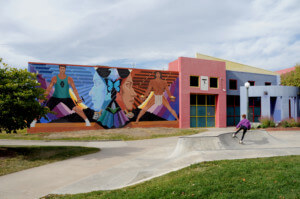Here at AN we’ve seen our share of Richard Neutra tear downs in recent years. The latest possible victim is Neutra and Robert Alexander’s campus-wide buildings at Orange Coast College in Costa Mesa, which are being threatened by the school’s bond-supported Vision 2020 plan (pdf). If the plan passes the school could tear down the duo’s classrooms, library, business education building, and science wing, as well as extensive landscaping by famed landscape architect Garrett Eckbo, in favor of new buildings, an Urban Street, and a Grand Lawn. The undertaking would be largely funded by 2012’s $698 million Bond Measure R, and total about 250,000 square feet of new construction.
According to the Cultural Landscape Foundation, “Rehabilitation of these sensitively designed productive buildings and landscape would be a more culturally and environmentally sensitive plan (especially in light of California’s severe drought cycle) than demolishing them and replacing them with turf.” Neutra historian Barbara Lamprecht has noted how the original plan’s “landscaping and buildings are finely meshed together with many interstitial spaces, covered walkways and breezeways, and volumes to permit changes in cadence and for rest. This low-rise weaving of light and shadow is a sharp contrast to what is proposed, a large quad surrounded by taller buildings, missing the gentle changes in scale evident in the existing campus.”
Per the the Vision 2020 facilities master plan, the school will need an additional 100,000 square feet of academic space by 2020, which the plan is seeking to address. Dr. Rich Pagel, Administrative Vice President at Orange Coast College, said the school’s facilities planning committee has recommended a combination of preservation, reuse, and teardown with regard to the historic buildings, adding that they plan to hire a consultant to undertake a historical structures report. He acknowledged the buildings’ legacy, but said the school needs to balance that with future growth. “When those buildings went up the campus was 1,500 students. Today we’re pushing 25,000 students,” he said, adding that many of the facilities are outdated for today’s learning. “There’s a strong desire to preserve the history but at the same time we have to think about the next fifty years,” he said.
According to a Historical Resources Technical Report for the project, the buildings could be eligible for listing in the National Register of Historic Places. A draft environmental impact report on the plan was completed in June, and the plan is now under review. The school’s Board of Trustees is scheduled to vote on the buildings’ fate in September or October. Local architect and preservationist John Linnert thinks partial preservation is a mistake: “Demolishing one and leaving two would only be a sad reminder of what once was, an amputation of sorts. Their is a wholeness that exists as a group. What is not understood sadly, is that underneath all of the over-the-years missteps, additions and poorly conceived modifications are buildings of great integrity and subtle yet powerful design.”










